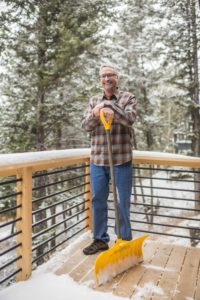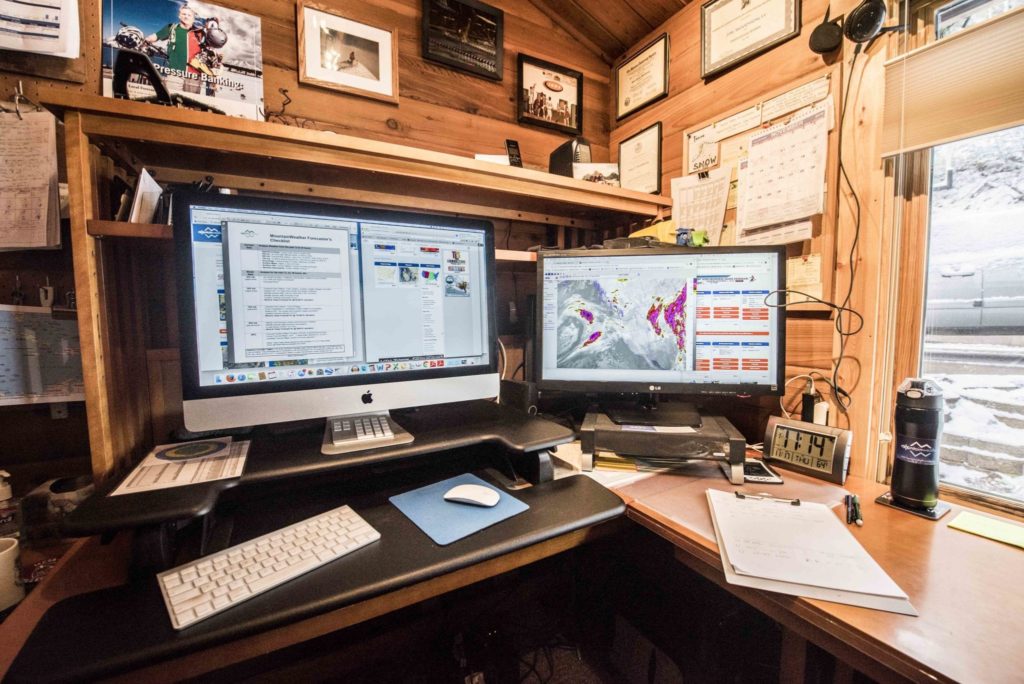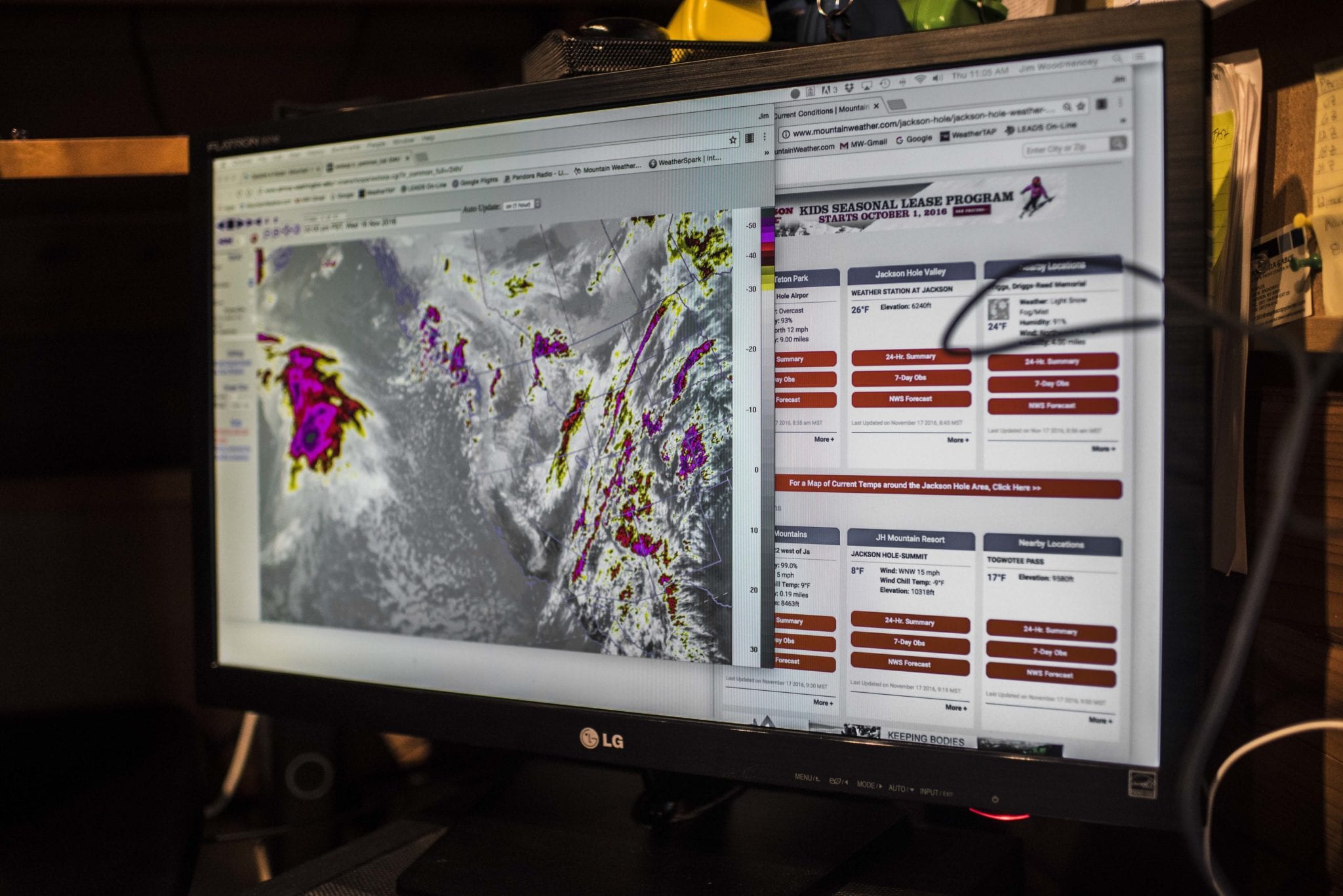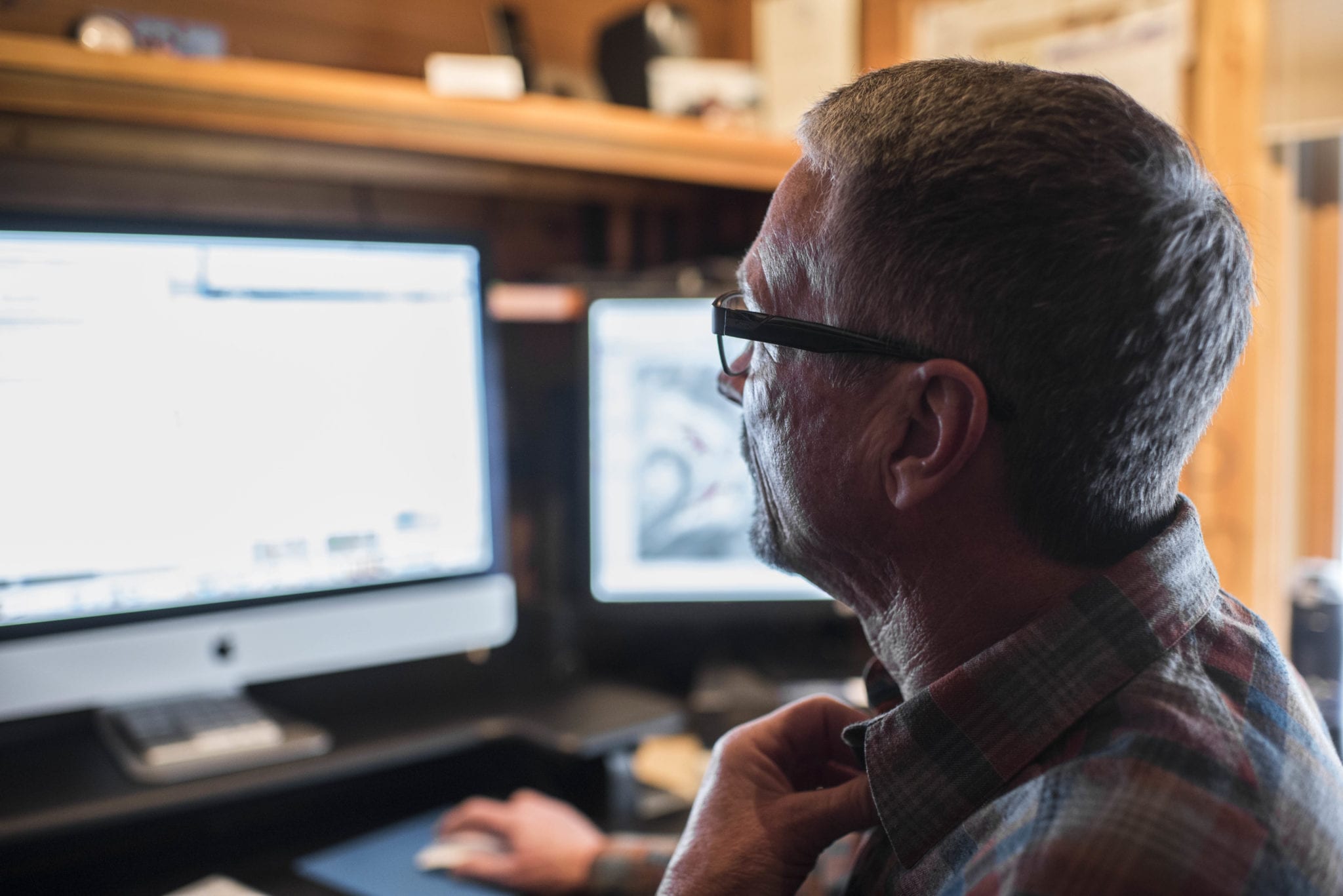It’s 4 a.m. in Jackson and Jim “Woody” Woodmencey is busy scribbling notes and pulling up map after map on his computer screen while the rest of the town sleeps. By 6 a.m. he has enough data to put out the day’s weather report, and for the next few hours he busies himself comparing computer models against over 30 years of his own experience to update the forecast for the week. “I never dread getting up in the morning because it’s always different,” he says of his early schedule, chuckling. “You just know it’s gonna screw you over – there’s always something that changes in a way I didn’t think it would.”
 While he did go to school for meteorology, Jim had no wild ambitions about being Jackson Hole’s most sought after weather forecaster. He didn’t want to do meteorology professionally at all, which in 1982 (when he graduated college), most likely meant working for the National Weather Service. “I didn’t want to go work for the Weather Service because I’d have to be in an office in a city,” he remembers. “I got into it because I was a climber and skier – I just wanted to learn more about weather.” So it was for those reasons that he moved to Jackson with his wife, Jan, to settle down, start a family, and pursue the ski bum lifestyle. Focusing on his two seasonal loves, he worked as a climbing ranger in Grand Teton National Park for 14 summers and took to the snow as a heli-ski guide in the winters.
While he did go to school for meteorology, Jim had no wild ambitions about being Jackson Hole’s most sought after weather forecaster. He didn’t want to do meteorology professionally at all, which in 1982 (when he graduated college), most likely meant working for the National Weather Service. “I didn’t want to go work for the Weather Service because I’d have to be in an office in a city,” he remembers. “I got into it because I was a climber and skier – I just wanted to learn more about weather.” So it was for those reasons that he moved to Jackson with his wife, Jan, to settle down, start a family, and pursue the ski bum lifestyle. Focusing on his two seasonal loves, he worked as a climbing ranger in Grand Teton National Park for 14 summers and took to the snow as a heli-ski guide in the winters.
It wasn’t until 1991 that his personal interest in weather began to take hold professionally. He bought his first computer and started to forecast for the heli-ski company, which in turn directly benefitted him. “You get more ski days if you’re looking carefully at the forecast,” he says. The NWS forecast wasn’t always complete enough for his team’s needs – sometimes they would have a cloudy weather report and call off flying for the day only to have it clear up by noon. “Even worse is if you fly in at 10 a.m. and it starts snowing and you have to bring everyone out,” he recalls. “Forecasters are given a forecast in raw form, and they can adjust it if they see something. But it’s not an easy task – a lot of it you base on personal experience. I look at a number of different computer models and they don’t always agree with each other.”
A couple of years later he was typing up and faxing the forecast daily to the heli-ski office when other businesses wanted to get in on the goods. By 1994, Jim was doing 3 live radio broadcasts in the morning that lasted 10-20 minutes each along with recordings that were played throughout the day. With numerous local businesses looking to sponsor him, he eventually stopped his job as a park ranger to make more time for meteorology. In 2008, he left behind ski guiding as well. “In the long run, I can forecast the weather with a bad knee – so for the future it was a good idea to cultivate the weather scene.”
These days, he’s still doing the Mountain Weather forecast Monday through Friday. He’s also often hired by experienced climbers who are planning committed alpine routes and can’t afford to get caught on the side of a mountain. Climbers hire Jim to forecast the right weather window for them to take on their climb. “Some things are missable,” he’s quick to remind me. “I just try to advise them to be on the lookout for when it could change or get bad.” So it’s not always the case of being able to predict the exact time the weather is going to do something, but to be able to tell climbers that on day 6 or 7 of their trip they may need to hunker down and wait out a storm. 
Tucked away in his office in the same cozy house he and his wife bought in the 80’s, it’s hard to believe this humble guy is one of the most experienced weather forecasters in the country. So experienced, in fact, that he’s the person teaching the Special Tactical Squadrons (STS) of the air force and army how to both forecast the weather as well as get certified in avalanche training. Most of the military personnel he works with are being deployed to locations where their primary responsibility is to forecast the weather in mountainous regions like Afghanistan for ground and air troops. It makes you wonder if he has a bat phone under his desk with a direct link to the oval office.
But when asked how exactly he would describe his job, he likes to keep it simple: “To forecast today and tomorrow’s weather.” He’s hesitant to predict things too far out, but since everyone in Jackson is antsy for some serious snow, I can’t resist bringing it up. “There’s a series of storms coming,” he says. “There should be two or three storms over the next couple weeks…but I can’t say exactly when with confidence.” He stops and thinks for a minute, adjusting his wire-rimmed glasses. “It’s not the forecast that’s wrong, it’s just the timing.” Guess we’ll all just have to cross our fingers and wait.


